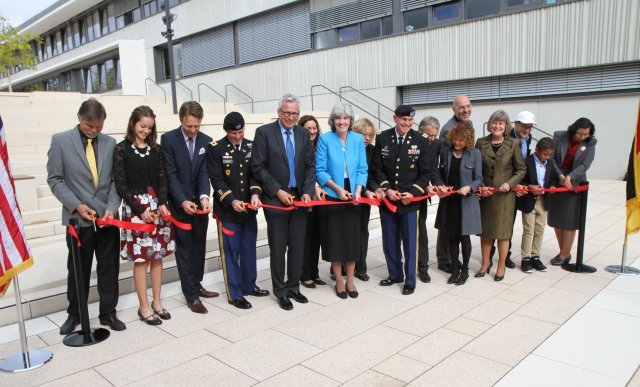
By Vince Little
USACE
Students across U.S. Army Garrison Stuttgart went back to school in early September. The community recently returned to dedicate the two newest marquee facilities in Department of Defense Education Activity-Europe’s inventory.
Post and education leaders, along with U.S. Army Corps of Engineers Europe District representatives and their German government design and construction partners, formally cut the ribbon on the new Stuttgart elementary and high schools during a ceremony Sept. 18 on Panzer Kaserne. The $98 million complex boasts a number of sustainability hallmarks and upgraded information technology throughout the buildings.
Officials praised the state-of-the-art campus as an institution that will have a lasting impact on students here today and those who follow in the decades to come.
Linda Curtis served as DODEA-Europe’s deputy director from 2006 to 2009, when discussions first surfaced about building new schools in the Stuttgart community.
“It’s great to be here again to see it all put together,” said Curtis, now DODEA’s deputy director and associate director of academics. “Now, the fun begins – the education and the learning, the building of tradition. … This new facility will be an integral part of the learning process. For us, it’s a winning combination.”
Classes started on time Sept. 2. The ribbon-cutting event was a chance for the stakeholders, students and faculty to celebrate the construction, completion and turnover of the schools.
The combined campus, which is connected to Panzer by a tunnel built as part of the project, covers about 245,000 square feet of education space. The high school was designed for a capacity of nearly 650 students, while 610 children can attend the elementary school.
“The great engineers … who came together with the [German regional construction office] to build this wonderful facility, working with our Corps of Engineers – what a great job they did,” said Col. Glenn Dickenson, the USAG Stuttgart commander. “And I got to tell you, after being in the Army for 25 years, I think this is the first project I have ever seen that’s been on time and ready to go when it was supposed to be.”
Groundbreaking took place in November 2013. USACE Europe District managed the project alongside its design team at Gaus & Aldinger and construction contractor, Wolff & Mueller.
Col. Matthew Tyler, the Europe District commander, said this campus replaces aging schools with modernized facilities. Delivering a 21st-century learning environment with the latest technologies and sustainability concepts can make all the difference in shaping leaders who will influence regional and global security in the future, he added.
“We are proud to serve and enable a larger goal to provide first-class education to our children,” he added. “[This complex] gives students the best possible opportunities to really dive into their educational growth.”
The Stuttgart schools feature new multipurpose rooms and high-tech computer labs. Playgrounds and a gymnasium were built at the elementary school, while the high school includes an auditorium, orchestra room, culinary arts kitchen, science rooms with robotics, indoor rifle range for junior ROTC cadets, and new synthetic-turf football and soccer field – surrounded by a track.
“It’s like a mini-university,” high school senior Kat Farrar told AFN Stuttgart. “There’s a lot more space. It’s a little harder to get around, but once you adjust, it’s so much better.”
Great vision was needed by the U.S. and local planners, designers and engineers, who had to meet stringent requirements to make the project a reality, said Reiner Trunk, finance president of Staatliches Hochbauamt Reutlingen, the German construction partner.
“It’s so awesome. We finished in time, and I’m very happy,” he said of the end result. “I want to thank the Corps of Engineers and all involved. We were able to build this school for the benefit of our common future.”
Stuttgart Elementary School and Stuttgart High School are also more than just a pair of new buildings on post. Engineers say they’re on track to earn the first Leadership in Energy and Environmental Design certification for a DODEA facility in Europe from the U.S. Green Building Council.
Tyler said the design incorporated sustainability measures that will increase the school complex’s life span and help preserve environmental resources for future generations by lowering annual energy costs and reducing the waste footprint. The campus also meets German environmental standards such as ENEV, an energy-saving regulation and efficiency requirement.
With the exception of one elementary facility, every school at USAG Stuttgart moved this summer, officials said. The former Patch High School was converted into a middle school for all area DODEA-Europe students.
“The project had a lot of challenges to overcome, but we did have a great team,” said Darrick Godfrey, Europe District’s Stuttgart Resident Office engineer. “The community is excited to see the new schools. Everyone seems impressed and happy to be in a new building with a lot of new things that they didn’t have before. … The science rooms are amazing. The band room, gym and football field are really nice. I would say the project is a success.”
The DODEA program is Europe District’s largest in terms of dollar amount. Overall, the Corps will manage the planning, design and construction of more than 30 current and future schools valued at over $1 billion throughout Germany and Belgium, affecting nearly 30,000 students around the Continent.
